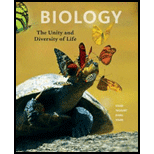
Concept explainers
To determine: In which cities did the researchers record the highest and lowest sperm counts.
Introduction: Nowadays, the agricultural fields are extremely contaminated with pesticides that are applied in fields to destroy all pests. Pesticides are harmful chemicals with no specificity and are equally harmful to all the living beings. The pesticide not only kills the living environment, it also destroys the reproductive function of animals whose wombs are exposed to such chemicals. In many researches, it was found that the men working in the agricultural fields are more exposed to the pesticide, which may adversely affect their reproductive capability.
Answer to Problem 1DAA
Correct answer: The highest sperm count is in City N and the lowest sperm count is in City C.
Explanation of Solution
Refer to Fig 34.22 “Characteristics of men in four cities” given in the question. Researcher S and her colleagues selected men from four cities from the US, namely City C, City L, City M and City N. Men from the cities were checked for their reproduction capabilities, especially the sperm count and sperm motility. From the given studies, it was found that men from the country with most farm lands were having a decreased sperm count and sperm motility. At the same time, the men in the area with no agriculture have the maximum sperm count and sperm motility.
Fig 34.22 shows that the sperm counts were 58.7 million/ml in City C (most of agricultural area) and in City N (with no agricultural area) the sperm count in men were 102.9 million/ml. Therefore, the city with the lowest sperm count is City C and the highest sperm count is in City N.
The highest sperm count is in City N and the lowest sperm count is in City C.
Want to see more full solutions like this?
Chapter 34 Solutions
Biology: The Unity and Diversity of Life (MindTap Course List)
- 22. Which of the following mutant proteins is expected to have a dominant negative effect when over- expressed in normal cells? a. mutant PI3-kinase that lacks the SH2 domain but retains the kinase function b. mutant Grb2 protein that cannot bind to RTK c. mutant RTK that lacks the extracellular domain d. mutant PDK that has the PH domain but lost the kinase function e. all of the abovearrow_forwardWhat is the label ?arrow_forwardCan you described the image? Can you explain the question as well their answer and how to get to an answer to an problem like this?arrow_forward
- Describe the principle of homeostasis.arrow_forwardExplain how the hormones of the glands listed below travel around the body to target organs and tissues : Pituitary gland Hypothalamus Thyroid Parathyroid Adrenal Pineal Pancreas(islets of langerhans) Gonads (testes and ovaries) Placentaarrow_forwardWhat are the functions of the hormones produced in the glands listed below: Pituitary gland Hypothalamus Thyroid Parathyroid Adrenal Pineal Pancreas(islets of langerhans) Gonads (testes and ovaries) Placentaarrow_forward
 Biology: The Dynamic Science (MindTap Course List)BiologyISBN:9781305389892Author:Peter J. Russell, Paul E. Hertz, Beverly McMillanPublisher:Cengage Learning
Biology: The Dynamic Science (MindTap Course List)BiologyISBN:9781305389892Author:Peter J. Russell, Paul E. Hertz, Beverly McMillanPublisher:Cengage Learning Biology: The Unity and Diversity of Life (MindTap...BiologyISBN:9781305073951Author:Cecie Starr, Ralph Taggart, Christine Evers, Lisa StarrPublisher:Cengage Learning
Biology: The Unity and Diversity of Life (MindTap...BiologyISBN:9781305073951Author:Cecie Starr, Ralph Taggart, Christine Evers, Lisa StarrPublisher:Cengage Learning Human Heredity: Principles and Issues (MindTap Co...BiologyISBN:9781305251052Author:Michael CummingsPublisher:Cengage Learning
Human Heredity: Principles and Issues (MindTap Co...BiologyISBN:9781305251052Author:Michael CummingsPublisher:Cengage Learning Anatomy & PhysiologyBiologyISBN:9781938168130Author:Kelly A. Young, James A. Wise, Peter DeSaix, Dean H. Kruse, Brandon Poe, Eddie Johnson, Jody E. Johnson, Oksana Korol, J. Gordon Betts, Mark WomblePublisher:OpenStax College
Anatomy & PhysiologyBiologyISBN:9781938168130Author:Kelly A. Young, James A. Wise, Peter DeSaix, Dean H. Kruse, Brandon Poe, Eddie Johnson, Jody E. Johnson, Oksana Korol, J. Gordon Betts, Mark WomblePublisher:OpenStax College





